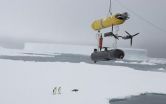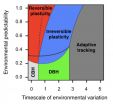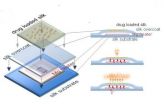(Press-News.org) SAN ANTONIO (Nov. 24, 2014) -- HIV-1-infected U.S. military members and beneficiaries treated with antiretroviral therapy (ART) soon after infection were half as likely to develop AIDS and were more likely to reconstitute their immune-fighting CD4+ T-cells to normal levels, researchers reported Nov. 24 in JAMA Internal Medicine.
Other immune benefits of starting treatment early and reaching a normal CD4+ T-cell count on therapy were also reported, including reductions in the activation state of T-cells, which influences HIV disease course, and improvements in the ability to mount robust immune responses such as a better response to hepatitis B vaccine. In a previous report published in 2013 in The New England Journal of Medicine, the authors defined a normal CD4+ T-cell count as values above 800 cells per cubic millimeter. In the current study, they report that the two conditions that favored reaching a normal CD4+ count were initiation of treatment within 12 months of seroconversion and having CD4+ T-cell counts greater than 500 cells per cubic millimeter at the time of commencing ART.
The study, which included authors from the School of Medicine at The University of Texas Health Science Center at San Antonio; the Veterans Affairs (VA) Research Center for AIDS and HIV-1 Infection and the VA Center for Personalized Medicine at the South Texas Veterans Health Care System; and the Uniformed Services University of Health Sciences, utilized U.S. Army, Air Force, Marines and Navy treatment and outcomes data of more than 1,100 soldiers and beneficiaries diagnosed with HIV-1.
"The immune system can be reconstituted most effectively and durably if ART is initiated quickly after infection," said senior author Sunil K. Ahuja, M.D., professor of medicine, microbiology/immunology and biochemistry in the School of Medicine at the UT Health Science Center San Antonio. Dr. Ahuja is director of the VA centers listed above. The research affirms the importance of a public health strategy that includes frequent testing for HIV infection in persons at risk of acquiring HIV, and prompt initiation of ART soon after infection, regardless of the CD4+ count at time of diagnosis, the authors wrote. "While the practice has been to generally defer ART till CD4+ counts decline to less than 500 cells per cubic millimeter, our results suggest that any delay in ART even in people maintaining higher levels of CD4+ counts impairs their ability to subsequently normalize CD4+ T-cell counts," Dr. Ahuja said.
Current recommendations focus on suppressing the virus. "Drug regimens have become much more potent, so it is possible to suppress HIV quite easily," Jason F. Okulicz, M.D., a first author of the study, said. "We are suggesting that achieving normalization of immunologic health comparable to that of an uninfected person, and making it stick for the long term, is also a critical goal. Conceivably this level of normalization of CD4+ counts will associate with a dampening of the risk for non-AIDS-related diseases we see frequently in our patients." Dr. Okulicz is the director of the HIV Medical Evaluation Unit at the San Antonio Military Medical Center and provides HIV care for all active-duty Air Force members. He also oversees HIV care for Army and Navy members, retirees and military beneficiaries.
"These studies also reflect a wonderful long-standing collaboration between investigators at the Veterans Administration and the UT Health Science Center and those at the San Antonio Military Medical Center," Dr. Ahuja said. "I have cherished this scientific partnership."
INFORMATION:
The work in San Antonio was supported by the Veterans Affairs (VA) Center for AIDS and HIV Infection and VA Center for Personalized Medicine of the South Texas Veterans Health Care System, a National Institutes of Health (NIH) MERIT grant (R37AI046326), and a Doris Duke Distinguished Clinical Scientist Award to Sunil K. Ahuja. Dr. Ahuja is also supported by a VA MERIT award, the Elizabeth Glaser Pediatric AIDS Foundation, a Burroughs Wellcome Clinical Scientist Award in Translational Research and a Senior Scholar Award from the Max and Minnie Tomerlin Voelcker Fund. This work was also supported by NIH grant UL1TR001120 (Clinical and Translational Science Award). Tuan Le was supported by a VA Career Development Award-2. Edwina Wright was supported by an Early Career Fellowship from the National Health and Medical Research Council of Australia. Support for this work (IDCRP-000-03) was provided by the Infectious Disease Clinical Research Program (IDCRP), a U.S. Department of Defense (DoD) program executed through the Uniformed Services University of the Health Sciences. This project has been funded in whole, or in part, with federal funds from the National Institute of Allergy and Infectious Diseases, National Institutes of Health (NIH), under Inter-Agency Agreement Y1-AI-5072. The work at the University of California, San Diego was supported by grants from the NIH (DA034978, AI43638, AI69432, MH62512, AI74621, MH097520, AI077304, AI007384, AI080193 and AI096113) and the International AIDS Vaccine Initiative (DMS0714991). The CHARTER cohort was supported by a grant from the National Institute of Mental Health (HHSN271201000027C).
For current news from the UT Health Science Center San Antonio, please visit our news release website, like us on Twitter or follow us on Facebook.
The University of Texas Health Science Center at San Antonio, one of the country's leading health sciences universities, ranks in the top 3 percent of academic institutions receiving National Institutes of Health funding. The university's schools of medicine, nursing, dentistry, health professions and graduate biomedical sciences have produced more than 29,000 graduates. The $787.7 million operating budget supports eight campuses in San Antonio, Laredo, Harlingen and Edinburg. For more information on the many ways "We make lives better®," visit http://www.uthscsa.edu.
MADISON, Wis. -- Sixty years ago, the plows ended their reign and the fields were allowed to return to nature -- allowed to become the woodland forests they once were.
But even now, the ghosts of land-use past haunt these woods. New research by Philip Hahn and John Orrock at the University of Wisconsin-Madison on the recovery of South Carolina longleaf pine woodlands once used for cropland shows just how long lasting the legacy of agriculture can be in the recovery of natural places.
By comparing grasshoppers found at woodland sites once used for agriculture to similar ...
UCLA neurophysicists have found that space-mapping neurons in the brain react differently to virtual reality than they do to real-world environments. Their findings could be significant for people who use virtual reality for gaming, military, commercial, scientific or other purposes.
"The pattern of activity in a brain region involved in spatial learning in the virtual world is completely different than when it processes activity in the real world," said Mayank Mehta, a UCLA professor of physics, neurology and neurobiology in the UCLA College and the study's senior author. ...
Single-cell phytoplankton in the ocean are responsible for roughly half of global oxygen production, despite vast tracts of the open ocean that are devoid of life-sustaining nutrients. While phytoplankton's ability to adjust their physiology to exploit limited nutrients in the open ocean has been well documented, little is understood about how variations in microbial biodiversity -- the number and variety of marine microbes - affects global ocean function.
In a paper published in PNAS on Monday November 24, scientists laid out a robust new framework based on in situ observations ...
DURHAM, N.C. -- Nearly four decades of observations of Tanzanian chimpanzees has revealed that the mothers of sons are about 25 percent more social than the mothers of daughters. Boy moms were found to spend about two hours more per day with other chimpanzees than the girl moms did.
Chimpanzees have a male-dominated society in which rank is a constant struggle and females with infants might face physical violence and even infanticide. It would be safer in general to just avoid groups where aggressive males are present, yet the mothers of sons choose to do so anyway.
"It ...
A National Science Foundation (NSF)-funded research team has successfully tested an autonomous underwater vehicle, AUV, that can produce high-resolution, three-dimensional maps of Antarctic sea ice. SeaBED, as the vehicle is known, measured and mapped the underside of sea-ice floes in three areas off the Antarctic Peninsula that were previously inaccessible.
The results of the research were published this week in the journal Nature Geoscience. Scientists at the Institute of Antarctic and Marine Science (Australia), Antarctic Climate and Ecosystem Cooperative Research ...
Coral reefs persist in a balance between reef construction and reef breakdown. As corals grow, they construct the complex calcium carbonate framework that provides habitat for fish and other reef organisms. Simultaneously, bioeroders, such as parrotfish and boring marine worms, breakdown the reef structure into rubble and the sand that nourishes our beaches. For reefs to persist, rates of reef construction must exceed reef breakdown. This balance is threatened by increasing atmospheric carbon dioxide, which causes ocean acidification (decreasing ocean pH). Prior research ...
LIND, Wash. - In the world's driest rainfed wheat region, Washington State University researchers have identified summer fallow management practices that can make all the difference for farmers, water and soil conservation, and air quality.
Wheat growers in the Horse Heaven Hills of south-central Washington farm with an average of 6-8 inches of rain a year. Wind erosion has caused blowing dust that exceeded federal air quality standards 20 times in the past 10 years.
"Some of these events caused complete brown outs, zero visibility, closed freeways," said WSU research ...
Researchers from North Carolina State University have created a model that mimics how differently adapted populations may respond to rapid climate change. Their findings demonstrate that depending on a population's adaptive strategy, even tiny changes in climate variability can create a "tipping point" that sends the population into extinction.
Carlos Botero, postdoctoral fellow with the Initiative on Biological Complexity and the Southeast Climate Science Center at NC State and assistant professor of biology at Washington State University, wanted to find out how diverse ...
Last year, University of Pennsylvania researchers Alexander J. Stewart and Joshua B. Plotkin published a mathematical explanation for why cooperation and generosity have evolved in nature. Using the classical game theory match-up known as the Prisoner's Dilemma, they found that generous strategies were the only ones that could persist and succeed in a multi-player, iterated version of the game over the long term.
But now they've come out with a somewhat less rosy view of evolution. With a new analysis of the Prisoner's Dilemma played in a large, evolving population, they ...
MEDFORD/SOMERVILLE, Mass. (Nov. 24, 2014, 3 P.M.) -- Researchers at Tufts University, in collaboration with a team at the University of Illinois at Champaign-Urbana, have demonstrated a resorbable electronic implant that eliminated bacterial infection in mice by delivering heat to infected tissue when triggered by a remote wireless signal. The silk and magnesium devices then harmlessly dissolved in the test animals. The technique had previously been demonstrated only in vitro. The research is published online in the Proceedings of the National Academy of Sciences Early ...





